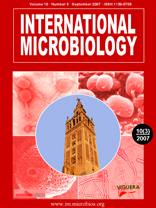Analysis of s-triazine-degrading microbial communities in soils using most-probable-number enumeration and tetrazolium-salt detection
Keywords:
Pseudomonas sp. ADP, s-triazine, simazine, atrazine, tetrazolium salt, herbicides, biodegradationAbstract
A simple and sensitive method for the detection and enumeration of microbial s-triazine-degrading microorganisms in soil was designed. The procedure is based on the ability of some microbes to use s-triazines, such as simazine, atrazine, and cyanuric acid, as sole nitrogen source. It employs the respiration indicator 2,3,5-triphenyl-2H-tetrazolium chloride (TTC) to detect metabolic activity and the most-probable-number (MPN) enumeration in microtiter plates. The method was used to identify simazine- and cyanuric acid-degrading activities in agricultural soils treated with the herbicide simazine. The MPN-TTC method showed that the number of simazine- and cyanuric acid-degrading microorganisms increased four weeks after the herbicide simazine had been applied. [Int Microbiol 2007; 10(3):209-215]Downloads
Published
2010-01-22
Issue
Section
Research Articles
License
Submission of a manuscript to International Microbiology implies: that the work described has not been published before, including publication in the World Wide Web (except in the form of an Abstract or as part of a published lecture, review, or thesis); that it is not under consideration for publication elsewhere; that all the coauthors have agreed to its publication. The corresponding author signs for and accepts responsability for releasing this material and will act on behalf of any and all coauthors regarding the editorial review and publication process.If an article is accepted for publication in International Microbiology, the authors (or other copyright holder) must transfer to the journal the right–not exclusive–to reproduce and distribute the article including reprints, translations, photographic reproductions, microform, electronic form (offline, online) or any other reproductions of similar nature. Nevertheless, all article in International Microbiology will be available on the Internet to any reader at no cost. The journal allows users to freely download, copy, print, distribute, search, and link to the full text of any article, provided the authorship and source of the published article is cited. The copyright owner's consent does not include copying for new works, or resale. In these cases, the specific written permission of International Microbiology must first be obtained.
Authors are requested to create a link to the published article on the journal's website. The link must be accompanied by the following text: "The original publication is available on LINK at <http://www.im.microbios.org>. Please use the appropiate URL for the article in LINK. Articles disseminated via LINK are indexed, abstracted, and referenced by many abstracting and information services, bibliographic networks, subscription agencies, library networks, and consortia.




